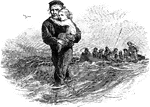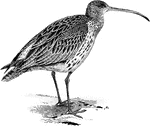
Curlew
"Numenius arquata, the Curlew or Whaup, breeds freely on the moorlands of Britain; and extends throughout…
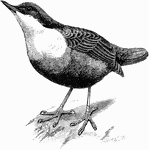
Dipper
"Cinclus aquaticus, Dippers, the colour above is normally greyish-black or brown; the lower parts are…

A Still Showing the Separation of a Liquid from a Solid
"Figure 5 shows a form of the apparatus for separating a liquid from another of different boiling point,…

Thermodynamics Apparatus Showing the Relationship between the First and Second Principals
"The falling weights EE turned a paddle-wheel stirrer inside the cylindrical vessel G, which was filled…

The Water Turned into Wine at Cana of Galilee
"And there were set there six waterpots of stone, after the manner of the purifying of the Jews, containing…

Jesus Washing the Feet of His Disciples
"He riseth from supper, and laid aside his garments; and took a towel, and girded himself. After that…

They Cried, Let Him Be Crucified
"Pilate saith unto them, What shall I do then with Jesus which is called Christ? They all say unto him,…

Abraham's Servant Meeting Rebekah
"And the servant ran to meet her, and said, Let me, I pray thee, drink a little water of thy pitcher."…

Moses Brought Before Pharaoh's Daughter
"And the child grew, and she brought him unto Pharaoh's daughter, and he became her son. And she called…
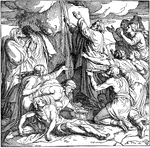
Moses Bringing Water from the Rock
"Behold, I will stand before thee there upon the rock in Horeb; and thou shalt smite the rock, and there…

The Hebrews Crossing the Jordan
"And it came to pass, when the people removed from their tents, to pass over the Jordan, the priests…
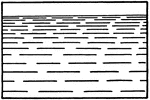
Water
Mechanical drawing convention for identifying water. Using conventionalized patterns to identify materials…

Virginia Cut Grass
Indian Rice Grass (Zizania aquatica), also known as Wild Rice, or Water Oats, is found in swampy borders…

Indian Rice Grass
Indian Rice Grass (Zizania aquatica), also known as Wild Rice, or Water Oats, is found in swampy borders…
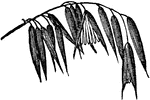
Indian Rice Grass
Indian Rice Grass (Zizania aquatica), also known as Wild Rice, or Water Oats, is found in swampy borders…
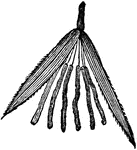
Indian Rice Grass
Indian Rice Grass (Zizania aquatica), also known as Wild Rice, or Water Oats, is found in swampy borders…
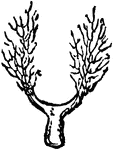
Indian Rice Grass
Indian Rice Grass (Zizania aquatica), also known as Wild Rice, or Water Oats, is found in swampy borders…
Indian Rice Grass
Indian Rice Grass (Zizania aquatica), also known as Wild Rice, or Water Oats, is found in swampy borders…
Indian Rice Grass
Indian Rice Grass (Zizania aquatica), also known as Wild Rice, or Water Oats, is found in swampy borders…
Indian Rice Grass
Indian Rice Grass (Zizania aquatica), also known as Wild Rice, or Water Oats, is found in swampy borders…
Floating Foxtail Grass
The Floating Foxtail (Alopecurus geniculatus) has a stem ascending, bent, and forming knees at the lower…

Floating Foxtail Grass
The Floating Foxtail (Alopecurus geniculatus) has a stem ascending, bent, and forming knees at the lower…

Water Spear Grass
Water Spear grass (Glyceria aquatica), also known as Reed Meadow grass, grows in wet soils and the shallow…
Water Spear Grass
Water Spear grass (Glyceria aquatica), also known as Reed Meadow grass, grows in wet soils and the shallow…

Water Hair Grass
Water Hair Grass (Aira aquatica) is the sweetest of the British grasses. Its stems and leaves when green…

Watterson's Call for Peaceful March
Cold water poured on Henry Watterson's call for peaceful march on Washington. "Fire and water make vapor…
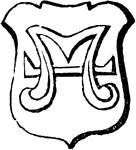
Boujet
"Argent, a boujet proper. BOUJET. An ancient water bucket, frequently borne in shields of arms." -Hall,…
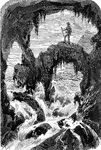
Mendocino Coast Erosion
Erosion is the removal of solids (sediment, soil, rock and other particles) in the natural environment.…

Shore Erosion and Distribution of Sediments
The floor of the sea was first formed or rocks that had cooled from a state of fusion. The few islands…
Sandstone
Along the south shore of Lake Superior is a sandstone once regarded as belonging to the Potsdam, but…
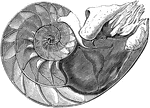
Pearly Nautilus
The Pearly Nautilus (Nautilus Pompilius) is the only living representative of a unique form of cephalopod,…
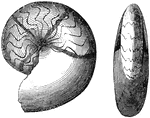
Coiled Chambered Shell
Goniatites are extinct ammonoids, shelled cephalopods related to squid, octopus, and belemnites, that…

Bad Lands of Dakota
In the Dakotah (Dakota) Territory, the area know as the Bad Lands, is a sunken area thirty miles wide…
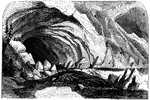
Glacier
A glacier is a large, slow-moving mass of ice, formed from compacted layers of snow. Glacier ice is…

Phenomena of Wells and Springs in Drift Material
Drift material, loose material left on the surface by a retiring glacier, plays a part in wells and…

Arched Rock
Arched rock is a natural limestone arch formed during the Nipissing post-glacial period, a period of…
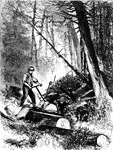
Buried Swamp
Ancient cedar trees were found buried beneath the Dennisvill swamp in southern New Jersey. It was believed…
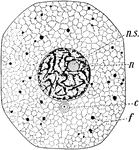
Typical amimal cell
A typical cell consists of two portions, one, te firmer, forming an excessively delicate meshwork enclosing…

Flagellate Infusoria
Infusoria is an obsolete collective term for minute aquatic creatures like ciliates, euglenoids, protozoa,…
Vorticella
The Bell Animalcule (Vorticella) (fig 10) in certain respects resembles the Slipper Animalcule. It is…
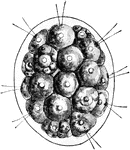
Pandorina
Pandorina, a one-celled, fresh water form, is a genus of green algae composed of 8, 16, or sometimes…

Sponge
Calcolynthus primigenius, a simple sponge with the wall removed to show the inside. It is hollow, attached…

Hydra Jellyfish
Fresh water Hydra, a jellyfish, is a many celled animal. Shown enlarged 25 times, is the entire animal.

Hydra Jellyfish
Fresh water Hydra, a jellyfish, is a many celled animal. Shown is a Hydra nettle cells.

Hydra Jellyfish
Fresh water Hydra, a jellyfish, is a many celled animal. The organs of defence, nettle cells or lasso…
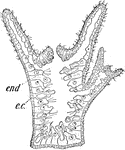
Hydra Jellyfish
Fresh water Hydra, a jellyfish, is a many celled animal. The organs of defence, nettle cells or lasso…
Flatworm
Flatworms are flattened, leaf-like forms living in damp places on land, in freshwater streams of ponds,…

Flatworm
Flatworms are flattened, leaf-like forms living in damp places on land, in freshwater streams of ponds,…
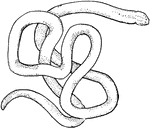
Nemetean
Band or Nemetean worms have been discovered in damp soil or in fresh-water streams. These are commonly…

Nemetean
Band or Nemetean worms have been discovered in damp soil or in fresh-water streams. These are commonly…

Cyclops
Cyclops, the representative of a number of lowly forms belonging to the order of Copepods, is one of…
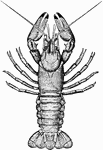
Crayfish
Crayfish, crawfish, or crawdads are freshwater crustaceans resembling small lobsters, to which they…

Crayfish
Crayfish, crawfish, or crawdads are freshwater crustaceans resembling small lobsters, to which they…
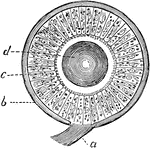
Sense of Hearing
Hearing is the perception of certain vibrations of bodies. These vibrations give rise to sound waves.…

Sense of Hearing
Hearing is the perception of certain vibrations of bodies. These vibrations give rise to sound waves.…

Sense of Hearing
Hearing is the perception of certain vibrations of bodies. These vibrations give rise to sound waves.…

Sense of Hearing
Hearing is the perception of certain vibrations of bodies. These vibrations give rise to sound waves.…
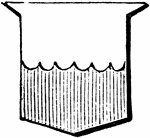
Party Per Fess Engrailed
"Party per fess, engrailed, argent and gules. PARTY PER FESS. A shield parted in the centre by an horizontal…

Girl Heating Water in Tea Kettle
An illustration of a girl heating water in the stove in a tea kettle.
